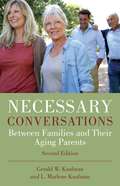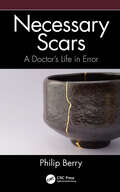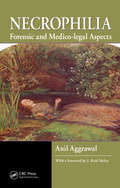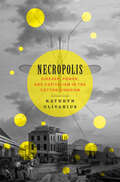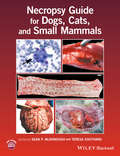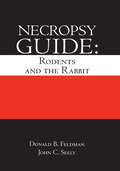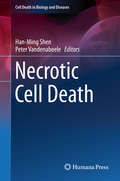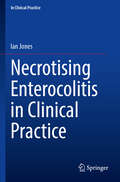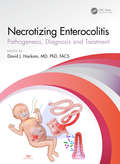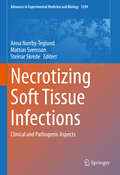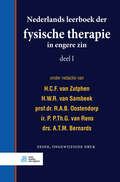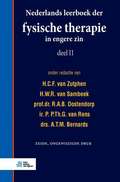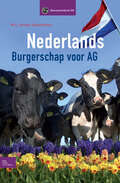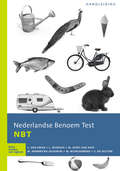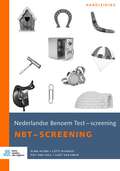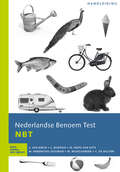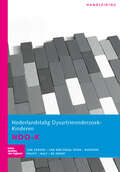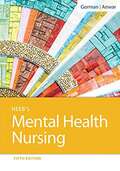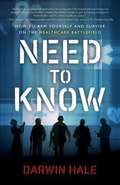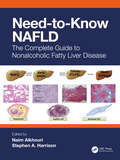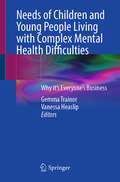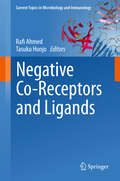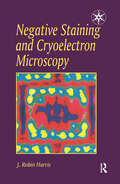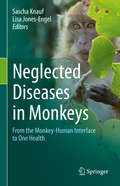- Table View
- List View
Necessary Conversations: Between Families and Their Aging Parents
by Gerald Kaufman L. Marlene KaufmanIn this timely book, long-time family counselors, Gerald and Marlene Kaufman, urge aging people, their adult children, family members, and other caretakers to talk directly with each other about the decisions that lie ahead as they age. "Do it before a crisis hits," say the Kaufmans. "A good time to start is when the parents retire."Necessary Conversations focuses on four primary areas:Parents' finances Parents' medical care Parents' living arrangements When to stop driving This honest and resourceful guide for aging adults and their family members includes helpful suggestions for starting these conversations and overcoming confrontation.
Necessary Scars: A Doctor's Life in Error
by Philip BerryWhether you are a doctor, nurse, student, or otherwise interested reader, the stories here will help you to understand how medicine works and how medical error can happen. The lifelong process of learning that is a medical career requires healthcare workers to find a way to live through these setbacks without either becoming too adept at putting them 'down to experience' and forgetting their social significance, or 'burning out' and leaving medicine. The stories and discussions here present detailed narratives, analyses, and reflections on medical errors through actions, omissions, and misunderstandings. They offer a uniquely honest perspective on the social implications of medical error and will enable healthcare workers at all levels to analyse and learn from it without losing sight of its impact.
Necrophilia: Forensic and Medico-legal Aspects
by Anil AggrawalNecrophilia: Forensic and Medico-legal Aspects is the first text that deals with the scientific aspects of necrophilia from a multidisciplinary point of view. After an introduction that provides a general scientific, social, and historical perspective, this volume:Explores causes and contributing factors, covering biological theories and genetics, as well as trauma, brain anomalies, and substance abuseOffers an original approach to classification, creating ten levels of severity from role playing to homicidal necrophiliaDiscusses necrophilia epidemiology, exploring offender characteristics and habitsProvides 20 case studies of infamous as well as less publicized casesDetails the forensics approach to necrophilia investigationExamines current legislation and mores across the worldExplains the challenges involved with providing expert testimony
Necropolis: Disease, Power, and Capitalism in the Cotton Kingdom
by Kathryn OlivariusDisease is thought to be a great leveler of humanity, but in antebellum New Orleans acquiring immunity from the scourge of yellow fever magnified the brutal inequities of slave-powered capitalism. Antebellum New Orleans sat at the heart of America’s slave and cotton kingdoms. It was also where yellow fever epidemics killed as many as 150,000 people during the nineteenth century. With little understanding of mosquito-borne viruses—and meager public health infrastructure—a person’s only protection against the scourge was to “get acclimated” by surviving the disease. About half of those who contracted yellow fever died. Repeated epidemics bolstered New Orleans’s strict racial hierarchy by introducing another hierarchy, what Kathryn Olivarius terms “immunocapital.” As this highly original analysis shows, white survivors could leverage their immunity as evidence that they had paid their biological dues and could then pursue economic and political advancement. For enslaved Blacks, the story was different. Immunity protected them from yellow fever, but as embodied capital, they saw the social and monetary value of their acclimation accrue to their white owners. Whereas immunity conferred opportunity and privilege on whites, it relegated enslaved people to the most grueling labor. The question of good health—who has it, who doesn’t, and why—is always in part political. Necropolis shows how powerful nineteenth-century white Orleanians—all allegedly immune—pushed this politics to the extreme. They constructed a society that capitalized mortal risk and equated perceived immunity with creditworthiness and reliability. Instead of trying to curb yellow fever through sanitation or quarantines, immune white Orleanians took advantage of the chaos disease caused. Immunological discrimination therefore became one more form of bias in a society premised on inequality, one more channel by which capital disciplined and divided the population.
Necropsy Guide for Dogs, Cats, and Small Mammals
by Sean P. Mcdonough Teresa SouthardNecropsy Guide for Dogs, Cats, and Small Mammals is a complete, practical resource for performing necropsies on dogs, cats, rabbits, rodents, and ferrets in the veterinary clinic, animal shelter, research laboratory, or in the field. Provides practical guidance on all aspects of performing an necropsy on dogs, cats, and small mammals and interpreting the results Presents more than 200 full-color images to demonstrate techniques and findings Offers step-by-step instructions for the necropsy process and collecting samples Includes an anatomy review, discussion of dissection techniques, and list of common artifacts and post-mortem changes for each organ system Supports veterinarians in performing a necropsy in any setting, including animal shelters, veterinary clinics, research laboratories, and in the field
Necropsy Guide: Rodents and the Rabbit
by Donald B. Feldman John Curtis SeelyThis laboratory guidebook provides step-by-step procedures that will aid in the dissection and collection of major organs and tissues of the most common species of small animals used in biomedical research. Through extensive use of photographs and illustrations, it guides dissectors through a complete necropsy of each species for the purpose of collecting organs and tissues routinely examined by pathologists. The techniques described enable technicians to perform necropsies on almost any mammal in a precise and logical sequence, and collect tissue properly to avoid diagnostic errors. Morphological differences among the various species are discussed.
Necrotic Cell Death
by Peter Vandenabeele Han-Ming ShenStarting with discussion of basic concepts and the molecular mechanisms of necrosis, this book looks first at several forms of necrotic cell death that have been identified, including necroptosis, autophagic cell death, and PARP-mediated cell death. As necrotic cell death is increasingly known to play a critical role in many physiological processes, the next chapters discuss its effect on metabolism, inflammation, immunity, and development. Necrotic cell death is closely implicated in human diseases like cancer, so the next chapters examine its relevance to human diseases, and final chapters cover methodologies for measuring necrosis. This book presents comprehensive coverage of necrosis from recognized experts from leading academic and medical institutions around the world. In contrast to apoptosis, well-defined as a form of programmed cell death, necrosis used to be considered as accidental (i. e. , non-programmed) cell death, usually in response to a severe injury. Accumulating evidence now suggests, however, that necrosis is also programmed and controlled by distinctive "death machinery" in response to various stimuli like oxidative stress or DNA damage.
Necrotising Enterocolitis in Clinical Practice (In Clinical Practice)
by Ian JonesThere is a very large body of literature on Necrotising Enterocolitis (NEC), much of it is confusing and contradictory. This book consolidates all the relevant aspects to provide clinicians and especially trainees with an overview of this condition which informs clinical practice and aids critical appraisal of new research in this area. The topic of NEC is often a single chapter in a paediatric surgical or neonatology text. This book is an invaluable guide for anyone caring for neonates.
Necrotizing Enterocolitis: pathogenesis, diagnosis and treatment
by David HackamThis is the first textbook devoted entirely to understanding and treating necrotizing enterocolitis (NEC), one of the leading causes of death and disability in premature infants. NEC continues to occur in neonatal units across the world, and the overall mortality has remained stubbornly high since its first description decades ago. Despite significant research into NEC, and a greater understanding of its underlying causes, there is no single source of information to which the care team can turn for guidance. This book fills that important gap in clinical care. In selecting the topics for this inaugural textbook, three guiding principles have been followed. First, to include chapters that provide detailed information for the medical team – the doctors and nurses, the therapists and pharmacists, the chaplains and the child life workers – so that each team member can optimally recognize, prevent and treat patients with this disease. Second, to ensure that chapters cover the depth and breadth of the latest clinical and scientific research into NEC, each selected to identify specific preventative strategies or therapies for this disease. Third, and perhaps most importantly, to focus not only on the child with NEC, but also on the child’s family, in order to provide comprehensive information about a disease that families have barely heard about, until the jarring day when their precious infant is affected by it. This book therefore: serves as a "how-to guide" for the care of the infant with NEC summarises critical new research and offers guidelines for future key research areas addresses the complex and difficult issues surrounding care of the critically ill infant suffering from NEC Written for the entire health care team including paediatric surgeons, neonatologists, developmental paediatricians, epidemiologists, ethicists, child life professionals, therapists and specialist nurses, each team member will find this book of value. This book was written to demystify this cruel disease, and to unlock its closely held secrets of pathogenesis, diagnosis, treatment and prevention.
Necrotizing Soft Tissue Infections: Clinical and Pathogenic Aspects (Advances in Experimental Medicine and Biology #1294)
by Anna Norrby-Teglund Mattias Svensson Steinar SkredeThis volume aims to enhance the current understanding of clinical features, treatment and pathogenic aspects in necrotizing soft tissue infections. Various representative case studies are discussed to enhance the readers’ understanding of these complex diseases. Necrotizing soft tissue infections are rapidly spreading infections that may cause extensive soft tissue or limb loss, multiorgan failure and are associated with a considerable fatality rate. It is undisputed that rapid diagnosis and prompt intervention is directly related to survival. The initial presentation may be limited to unspecific symptoms such as tenderness, swelling, erythema and pain. Thus, diagnosis and management are challenging due to heterogeneity in clinical presentation, in co-morbidities, in microbiological aetiology, as well as in the pathogenic mechanisms. An international and multidisciplinary consortium, INFECT, has for the last 6 years been pursuing research aimed to advance the understanding of the clinical and pathogenic aspects of these infections. A central part has been to create a comprehensive clinical registry and associated biobank which have also formed the basis for the experimental studies. Using the INFECT patient cohort, as well as an integrated systems biology approach in patients and clinically relevant experimental models, an advanced insight of diagnostic features, causative microbial agents, treatment strategies, and pathogenic mechanisms (host and bacterial disease traits and their underlying interaction network) has been obtained.
Nederlands leerboek der fysische therapie in engere zin deel I
by H.C.F. van Zutphen H.W.R. van Sambeek R.A.B. Oostendorp P.P.Th.G. van Rens A.T.M. BernardsDit deel 1 bevat een inleiding over fysiotherapeutische basisbegrippen en hoofdstukken over o.a. fysiologie en pathofysiologie van nocisensoriek, gelijkstroom- en hoogfrequentelektrotherapie.
Nederlands leerboek der fysische therapie in engere zin deel II
by H.C.F. van Zutphen H.W.R. van Sambeek R.A.B. Oostendorp P.P.Th.G. van Rens A.T.M. BernardsDit deel 2 bevat hoofdstukken over o.a. lichttherapie, lasertherapie, lokale thermotherapie, saunatherapie, hydrotherapie, ultrageluidtherapie en ultrafonoforese-therapie en veiligheid.
Nederlands: Burgerschap voor AG (Basiswerk AG)
by M.C. Arnold-KlaarhamerIn het beroepsleven is een goede beheersing van het Nederlands, zowel mondeling als schriftelijk, van groot belang. Het basiswerk Nederlands, Burgerschap voor AG helpt elke mbo–student om de Nederlandse taal goed onder de knie te krijgen. De volgende onderwerpen komen aan bod:· spelling, grammatica en stijl;· mondelinge en schriftelijke informatie;· verslaglegging en rapportage; · verslaglegging en rapportage;· zakelijke correspondentie;· sollicitatieprocedure;· vergaderen.Daarbij is er aandacht voor e–mailetiquette en culturele verschillen. Ook de nieuwe eisen voor leren, loopbaan en burgerschap zijn in dit boek verwerkt. De student krijgt diverse opdrachten om de taalvaardigheid te trainen. Er wordt daarbij steeds verwezen naar praktijksituaties. Zodoende kan de student de link naar het toekomstige beroep leggen.Naast de lees– en schrijfvaardigheid is er aandacht voor de luistervaardigheid. Daarom hoort bij dit boek een cd met een luistertoets.
Nederlandse Benoem Test (NBT) handleiding
by M. Hendrickx-Jessurun Lotti Dijkhuis Margriet Wijngaarden Lizet van Ewijk M. Hofs-van Kats Carlijn de HilsterDoel van de testDe Nederlandse Benoem Test (NBT) is een meetinstrument voor het vaststellen van woordvindingsstoornissen bij volwassenen met een Niet Aangeboren Hersenletsel (NAH). De NBT bestaat uit 92 eenduidige afbeeldingen in kleur, opgebouwd op basis van verwervingsleeftijd en woordfrequentie. De test geeft hierdoor ook informatie over de aard van de woordvindingsstoornis. De afbeeldingen van de NBT zijn zorgvuldig uitgezocht voor de Nederlandse setting. De selectie is gebaseerd op de meest recente wetenschappelijke inzichten op het gebied van woordvinding en op de behoeftes en voorkeur van logopedisten en clienten. De test speelt in op de behoefte aan no-nonsense afbeeldingen geschikt voor volwassenen, met items speciaal geselecteerd voor de Nederlandse taal. De test is tot stand gekomen in samenwerking met logopedisten en clienten met NAH en een afasie, om zo samen een valide, betrouwbaar en gebruiksvriendelijk instrument te creeren. Toepassing• Screening: signaleert de aanwezigheid van woordvindstoornissen• Diagnose: inzetbaar in de diagnostiek van woordvindproblemen • Behandeling: meet de voorruitgang van gegeven therapie. • Onderzoek: toegevoegde waarde voor Nederlands onderzoek: de NBT is speciaal voor de Nederlandse populatie ontwikkeld. Wat meet de NBT?De Nederlandse Benoem Test meet woordvindproblemen bij volwassenen met een Niet Aangeboren Hersenletsel (NAH). De test is opgebouwd op basis van verwervingsleeftijd (2 categorieen) en woordfrequentie (3 categorieen) en geeft zo ook informatie over de aard van de woordvindingsstoornis. De test meet het hele woordvindingstraject. Voor wie?De NBT wordt in principe afgenomen door een logopedist of klinisch linguïst, maar ook professionals uit andere disciplines met affiniteit voor afasie en taal, zoals neuropsychologen, klinisch psychologen of neurologen kunnen met de NBT werken. Toelichting van een logopedist of klinisch linguïst is dan raadzaam.Afname en scoringDe afnameduur varieert tussen de 5 en de 30 minuten, afhankelijk van de ernst van de afasie. De afbeeldingen worden visueel aangeboden. De patient benoemt de afbeelding die hij/zij ziet. NormenOm na te gaan of er op basis van de NBT een juiste diagnose kan worden gesteld (predictieve validiteit) zijn de scores van gezonden en afatici met elkaar vergeleken. In de handleiding wordt een optimale cut-off score gegeven die het verschil tussen wel/geen stoornis aangeeft. MaterialenNBT- complete set NBT- scoreformulieren
Nederlandse Benoem Test - Screening (NBT - Screening) - handleiding: NBT - screening handleiding
by Lotti Dijkhuis Lizet van Ewijk Eline Alons Piet van TuijlDe Nederlandse Benoem Test - screening (NBT - screening) is een screeningsinstrument voor het vaststellen van woordvindstoornissen bij volwassenen met afasie.De NBT - screening is ontwikkeld voor professionals die snel en eenvoudig willen screenen op de aanwezigheid van woordvindstoornissen. Denk aan logopedisten in de acute fase, (neuro)psychologen en/of revalidatieartsen. De NBT - screening bevat verschillende sets, waarin het aantal afbeeldingen varieert tussen de 5 en de 10. Elke versie heeft een eigen betrouwbaarheid en afkapwaarde. Aan de professional de keuze om de set te kiezen die het beste binnen de werksetting past.De items in de NBT - screening zijn zorgvuldig gekozen, speciaal voor de Nederlandse taal. De no-nonsense afbeeldingen zijn herkenbaar en geschikt voor de volwassen doelgroep. De NBT - screening is tot stand gekomen in samenwerking met logopedisten. Het is een valide en betrouwbaar screeningsinstrument, en gebruiksvriendelijk voor zowel de professional als de cliënt met afasie.
Nederlandse Benoem Test NBT: Handleiding
by L. Van Ewijk L. Dijkhuis M. Hofs-van Kats M. Hendrickx-Jessurun M. Wijngaarden C. De HilsterDe Nederlandse Benoem Test (NBT) is een meetinstrument voor het vaststellen van woordvindingsstoornissen bij volwassenen met Niet Aangeboren Hersenletsel (NAH). De NBT bestaat uit 92 afbeeldingen in kleur (die visueel worden aangeboden), opgebouwd op basis van verwervingsleeftijd en woordfrequentie. De test geeft hierdoor ook informatie over de aard van de woordvindingsstoornis. De NBT bevat eenduidige afbeeldingen, die zorgvuldig zijn uitgezocht voor de Nederlandse setting. De selectie van de afbeeldingen is gebaseerd op de meest recente wetenschappelijke inzichten op het gebied van woordvinding, én op de behoeftes en voorkeur van logopedisten en cliënten. De test speelt in op de behoefte aan een benoemtest met no-nonsense afbeeldingen, geschikt voor volwassenen, met items geselecteerd voor de Nederlandse taal. Geen pretzel of juk, maar herkenbare items als hagelslag en zandbak. De test is tot stand gekomen in samenwerking met logopedisten en cliënten met NAH en een afasie, om zo samen een valide, betrouwbaar én gebruiksvriendelijk instrument te creëren.
Nederlandstalig Dysartrieonderzoek-Kinderen NDO-K: Handleiding
by Van Gerven van den Engel-Hoek Ruessink Knuijt Kalf De SwartDoel van de testHet NDO-K is een instrument waarmee de diagnose 'dysartrie' bij kinderen gesteld kan worden. Daarnaast kan met het instrument het type dysartrie en de ernst ervan worden vastgesteld. In Nederland was tot op heden geen dysartrieonderzoek voor kinderen beschikbaar. Met het verschijnen van het NDO-K is hierin verandering gekomen. Het NDO-K is een gestandaardiseerd, valide en betrouwbaar instrument dat kan bijdragen aan goede basis voor logopedische therapie. Het type en de ernst van de dysartrie worden in het NDO-K onderzocht met behulp van gestandaardiseerde spreekopdrachten. Alle aspecten van de spraak, te weten adem, fonatie, articulatie, nasale resonantie en prosodie worden met deze opdrachten in kaart gebracht. Het NDO-K is bedoeld voor kinderen bij wie een vermoeden bestaat van aanwezigheid van een dysartrie. Het instrument is geschikt om af te nemen in de acute fase, de revalidatiefase en de chronische fase.Toepassing•Diagnostiek: stelt de diagnose dysartrie en bepaalt het type en de ernst van de dysartrie.•Differentiaaldiagnose: het NDO-K onderscheidt dysartrie van andere spraakstoornissen.•Behandeling: vormt de basis voor een passend therapieplan.•Wetenschappelijk onderzoek: de maximum performancetaken en de leesteksten zijn geschikt voor het verzamelen van genormeerde data. Onderzoek heeft laten zien dat de ernstscore betrouwbaar vastgesteld kan worden. Wat onderzoekt het NDO-K?Het NDO-K onderzoekt alle aspecten van de spraak met behulp van 6 spreektaken, te weten:•1. spontane spraak•2. lezen van een standaard tekst of naspreektaken•3. diadochokinese•4. glijtonen•5. roepen•6. maximale aanhoudingsduurVoor wie?Het NDO-K kan door logopedisten afgenomen worden. Scoring en interpretatie kan betrouwbaar gedaan worden door logopedisten die ervaren en/of getraind zijn in het luisteren naar dysartrische spraak. Hiervoor worden ook NDO-K workshops gegeven door het Radboudumc, afdeling Revalidatie logopedie kinderen. Zie https://www.radboudumc.nl/afdelingen/revalidatie/paramedische-disciplines/logopedie/volwassenen-en-kinderen/logopedie-kinderen/scholingAfname en scoringDe afname gebeurt in een vaste volgorde en duurt 20 tot 30 minuten. De afname wordt bij voorkeur op video opgenomen. Scoring gebeurt tijdens en na de afname, zo nodig wordt voor de scoring de video-opname terug gekeken. Aan de hand hiervan kan een inschatting gemaakt worden van de mate waarin de prestatie afwijkt (onmogelijk, duidelijk afwijkend, licht afwijkend). Voor de maximale prestatietaken zijn referentiewaarden toegevoegd.Materialen• NDO-K complete set (handleiding, formulieren, therapiemateriaal)• NDO-K scoreformulieren (set van 25) • NDO-K workshop (via Radboudumc)
Neeb's Mental Health Nursing
by Linda M. Gorman Robynn AnwarHere’s the must-know information LPN/LVN students need to care for patients with mental health disorders where they’ll encounter them - in general patient care settings. <p><p> An easy-to-read, conversational writing style shows you how to recognize and respond to the most important mental health issues. You’ll also explore important communication techniques, ethical and legal issues, and alternative and complementary treatments. Coverage of nursing interventions, basic psychiatric nursing skills, and psychopharmacology prepares you for the NCLEX-PN® exam and clinical practice.
Need to Know: How to Arm Yourself and Survive on the Healthcare Battlefield
by Darwin HaleIllness, disease, and aging aren't the only things attacking your wellness. The US healthcare system has failed to evolve like other industries, remaining fragmented and inefficient, unable to keep up with the changing needs of citizens, particularly those of Medicare age and veterans. But there is hope. Eventually, you or a loved one will be drafted onto the healthcare battlefield--and the best time to prepare is now. <P><P>In Need to Know, Darwin Hale, a decorated retired military officer with more than twenty years in the healthcare arena, presents practical and objective strategies for managing the system's flaws based on military lessons learned. These solutions include how to <ul> <li>Navigate a system that can cure or kill you </li> <li>Use wellness to fight disease </li> <li>Prepare for the future of personalized medicine </li> <li>Arm yourself with a battle plan </li> </ul> <P><P>You don't have to fight alone. Need to Know cuts through the red tape so you can get the care you deserve.
Need-to-Know NAFLD: The Complete Guide to Nonalcoholic Fatty Liver Disease
by Naim Alkhouri Stephen A. HarrisonNonalcoholic fatty liver disease (NAFLD) is the hepatic manifestation of the obesity and metabolic syndrome epidemics, which this up-to-date book deals with comprehensively. The contents outline disease mechanisms, diagnostic tests, management, varying manifestations, and special populations. It covers the mechanistic pathways that contribute to NAFLD development, including the role of genetic variants and the gut microbiome. It elaborates on noninvasive diagnostic tests to screen for NAFLD, determine its severity, and monitor response to lifestyle intervention and pharmacologic treatment. This book helps clinicians diagnose and treat this common and potentially deadly disease. Key Features: Reviews current drugs in development and provides practical advice to clinicians on the diagnosis and management of fatty liver. Proves attractive to primary care providers who are on the front line of managing patients with NAFLD, to gastroenterologists and hepatologists who would benefit from updated data on how to risk-stratify patients and identify those who will be eligible for pharmacologic treatment, and other specialists such as cardiologists, endocrinologists, and nephrologists who will find this book to be a useful reference on the extrahepatic manifestations of NAFLD. Focuses on extrahepatic manifestations and new insights on the mechanistic drivers of the disease.
Needles, Herbs, Gods, and Ghosts: China, Healing, and the West to 1848
by Linda L. BarnesWhen did the West discover Chinese healing traditions? Most people might point to the "rediscovery" of Chinese acupuncture in the 1970s. In Needles, Herbs, Gods, and Ghosts, Linda Barnes leads us back, instead, to the thirteenth century to uncover the story of the West's earliest known encounters with Chinese understandings of illness and healing. As Westerners struggled to understand new peoples unfamiliar to them, how did they make sense of equally unfamiliar concepts and practices of healing? Barnes traces this story through the mid-nineteenth century, in both Europe and, eventually, the United States. She has unearthed numerous examples of Western missionaries, merchants, diplomats, and physicians in China, Europe, and America encountering and interpreting both Chinese people and their healing practices, and sometimes adopting their own versions of these practices. A medical anthropologist with a degree in comparative religion, Barnes illuminates the way constructions of medicine, religion, race, and the body informed Westerners' understanding of the Chinese and their healing traditions.
Needs of Children and Young People Living with Complex Mental Health Difficulties: Why it’s Everyone’s Business
by Vanessa Heaslip Gemma TrainorThis book highlights how it is increasingly important that nurses and other health and social care professionals working with or caring for children and young people (CYP) can contribute to the care and support these vulnerable individuals need. Given the limited specialist mental health services available for CYP, this book helps to recognise when referral to specialist services is required. It is aimed at providing nurses, other health and social care professionals with a comprehensive understanding of some of the complex mental health issues faced by young people today and to provide them with confidence in how to interact helpfully with them. While covering a range of complex mental health issues (such as self-harm, eating disorders, and psychosis) this book also explores wider factors that can influence poor mental health (such as being Looked After, having a disability, drugs and alcohol, and social media). Alongside these, it explores some of the wider systems and processes that can provide practical guidance to practitioners (having a Trauma-informed approach, awareness of risk management, and safeguarding). Lastly, the book recognises how overwhelming it can be for practitioners working in this field and explores how they can use reflective practice and self-care in the development of a therapeutic relationship that enables them to interact positively and non-judgementally with young people with complex mental health issues. Examples of good practice are provided throughout the book by using case scenarios and tips from young people with lived experience.This book will prove to be an invaluable guide to assist nurses, teachers, social workers, paramedics, health care assistants and police force in giving help and support to CYP.
Negative Co-Receptors and Ligands
by Tasuku Honjo Rafi AhmedAdaptive immune responses serve as a key defense mechanism for the control of infections in vertebrates. Immune responses must be of sufficient strength to contain invading pathogens, antigen specific responses require regulatory mechanisms to ensure termination or downmodulation to avoid excessive damage to the host tissue. For both branches of the adaptive immune system, regulatory molecules i.e. coreceptors and ligands have been identified that control the signaling cascades initiated by engagement of the T cell and B cell antigen receptors. This book describes biological functions as well as molecular mechanisms of these molecules.
Negative Staining and Cryoelectron Microscopy: The Thin Film Techniques
by 0 J.R. Harris,Since the start of biological studies using the transmission electron microscope scientists have sought to develop procedures for the preparation and investigation of the thinly spread specimens of biological particulates. Negative Staining and Cryoelect
Neglected Diseases in Monkeys: From the Monkey-Human Interface to One Health
by Lisa Jones-Engel Sascha KnaufThis book offers a valuable resource, reviewing the current state of knowledge concerning the pathology and epidemiology of infectious diseases in both captive and wild monkeys. The One Health concept forms the framework of all chapters. The multidisciplinary team of authors addresses neglected diseases caused by the three major pathogen groups - bacteria, viruses, and parasites. Moreover, the volume discusses key virulence factors such as the evolution of antibiotic resistance, and the ecological drivers of and human influence on pathogen transmission. Demonstrating how researchers working on monkeys diseases are increasingly thinking outside the box, this volume is an essential reference guide to the field of One Health and will serve as an asset for stakeholders in conservation, healthcare and research organizations that face the challenge of moving beyond classical human oriented approaches to health.
